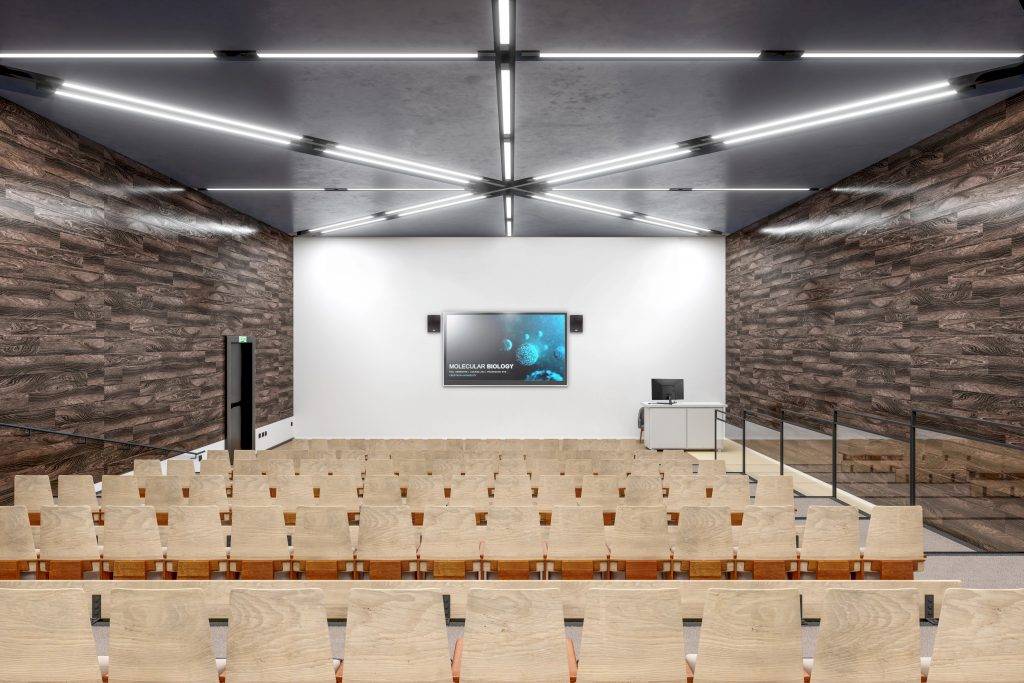
Are you curious about innovation in media technology? Or perhaps the evolution happening in meeting rooms? It seems like news articles are filled with discussions about artificial intelligence (AI) and its impact. But does it hold up in reality? Besides having tested Alexa in a conference room, I haven’t encountered true AI yet. However, let’s delve deeper into this subject and explore what currently exists and what exciting possibilities lie ahead.
Contents:
- What is AI?
- AI in media technology
- Machine Learning: The Key to Performance Optimization
- AI-Driven Automation: A Paradigm Shift in AV Technology
- Improving User Experience with AI: The Key to Customer Satisfaction
- Interesting Use Cases
- The Future of AI in AV Integration: A Glimpse Ahead
After reading this article, you will have a slightly better understanding of the topic of AI and how it could apply to the world of AV integrators. In an increasingly digital business world, adaptability to new technologies is crucial for success. One area where these changes are particularly noticeable is in audiovisual (AV) technology, especially when it comes to meeting rooms and conference systems. This is where artificial intelligence (AI) plays a central role.
What is AI?
Not everything labeled as “AI” truly embodies the scientific concept. In fact, when examining the term rigorously, the landscape of current solutions appears rather limited. In this article, we delve into the subject of “AI” as it is currently perceived by the majority – a product of machine learning, a remarkable avenue for technological advancements, devoid of aspects like singularity or artificial consciousness. Thus, we explore its evolutionary potential rather than a power seeking to rise against humanity, although this notion has certainly spawned some intriguing films.

Artificial Intelligence (AI) refers to technologies that resemble human intelligence through machine learning and analytical decision-making to detect complex patterns. AI can be employed to solve problems and tasks typically handled by humans. This technology finds applications across various industries to optimize operations and deliver more efficient solutions for specific tasks. So it is more likely to be considered a tool to use rather than a technology with the goal of replacing workers.
AI in media technology
We have pondered extensively on the potential impact of AI in the world of media technology, both for AV integrators and users. Some aspects are already a reality today, although perhaps not yet perfect. Other aspects we discuss here might still be considered futuristic, and we hope you’ll excuse our imagination. However, we also hope that you share our interest and enthusiasm when it comes to exploring new realms of technology.
Machine learning: The key to performance optimization
Machine a subfield of AI, empowers AV systems to learn from data and continually enhance their performance. By analyzing vast datasets, these systems can identify patterns and make predictions, ultimately optimizing system performance. This can manifest in improved audio and video quality, efficient bandwidth utilization, and an overall enhanced user experience.
AI-driven automation: A paradigm shift in AV technology
Automation is a vital component of AI and a key element in modern AV technology. Utilizing AI enables conference systems and meeting rooms to be automatically adjusted and optimized, ensuring seamless usability. This encompasses features such as automatic calibration of cameras and microphones, guaranteeing optimal audio and video quality, as well as automatic adjustment of lighting and temperature based on user preferences.
Improving user experience with AI: The key to customer satisfaction
Improving the user experience is another area where AI can showcase its strengths. By leveraging AI, AV systems can be made more intuitive and user-friendly. AI-driven systems have the capacity to learn user preferences and automatically make adjustments to meet individual needs and preferences. This results in a personalized and satisfying user experience.
Interesting use cases
What potential use cases might be discovered through this exploration? We’ve let our imaginations run wild a bit, but not without reason. Some of these applications may extend beyond the realm of media technology, but that doesn’t detract from the possibilities. Moreover, as we move into 2023 and beyond, it’s crucial to consider not only office-based employees but also remote workers in home offices, and how they can be effectively and efficiently integrated through a hybrid work model.
Speech recognition and audio AI
Powered AI technology, speech recognition, and voice command have revolutionized sound quality in recording studios and live events. These cutting-edge systems provide an unprecedented level of audio excellence. By accurately detecting voice commands and following spoken instructions, they assist in differentiating between multiple voices on a track, automatically adjusting settings for optimal audio and video quality, and capturing high-quality recordings even in noisy environments. With AI-driven speech recognition, singers and musicians now have unparalleled control over their audio recordings.

Furthermore, with AI-driven speech recognition, it is now possible to automatically transcribe interviews or presentations, saving time and money while delivering accurate transcriptions. AI-driven speech recognition systems are also used for generating automatic translations, facilitating effective communication among people from different countries and backgrounds. Additionally, leveraging natural language processing (NLP), these systems can comprehend context and intent, enabling them to provide more effective customer service and support.
Visual AI for facial recognition and speaker tracking
Facial recognition technology has been around for some time, but with AI-powered visual recognition, it can do so much more than just identify faces. AI-driven facial recognition can now be used to detect facial expressions and reactions at events like speeches or presentations. This allows speakers and moderators to tailor their content accordingly and ensure that the audience stays engaged and actively involved. Visual AI is also utilized to track individual speakers during sessions and conferences, enabling organizers to keep an eye on who needs to be heard or even assist them in correcting poor posture.
Cameras equipped with AI-powered facial recognition technology can be used to automatically switch scenes during a conference or meeting. These cameras can recognize who is speaking and instantly switch to that person. This ensures that all speakers have the chance to be seen and heard. This technology can also be used to track the whereabouts of individual speakers in a room, allowing the camera to follow them as they move. The automatic tracking of speakers gives online broadcasts of conferences a much more professional look and makes it easier for viewers to engage.
Harness the power of machine learning for a cutting-edge user experience
Machine learning algorithms can be used to create a personalized experience for each viewer if their preferences are included in the dataset. For instance, if someone prefers watching videos at a slower pace, the algorithm can automatically adjust the scene transition speed, ensuring it’s neither too fast nor too slow. Moreover, individual viewers’ preferences can be considered in scene selection, providing them with more content that interests them. Machine learning can also enable the development of intelligent systems that can adjust the ambiance of a conference room based on the speaker, creating an immersive experience for the audience. This concept can be extended to other aspects as well, facilitating a seamless user journey.
Value-added digital signage with dynamic content
Digital signage equipped with AI-enabled analytics can offer users an enriching experience. By recognizing user behavior, digital signage can predict the type of content that users might enjoy in the future using machine learning algorithms. This allows for more precise recommendations and targeted advertising, resulting in a highly personalized experience. With this technology, digital Signage can also become an interactive medium, engaging users and keeping them updated on the latest news and developments from their favorite brands or interests.
Looking for an example? On the internet, it’s common to be shown advertisements for products or services based on your preferences and existing data. This same concept can be applied to digital signage advertising, as long as a camera is involved. When children are detected nearby, the signage player can display toy advertisements, while the playlist can switch to cater to the potential interests of adults when they are close by.
Improving speech clarity
One way artificial intelligence (AI) can assist in removing unwanted noise from a microphone is by utilizing AI algorithms and models to detect and eliminate such noise. In a conference call, for instance, additional background noises like typing, traffic, or the humming of an air conditioner might occur. By employing an AI algorithm trained to recognize specific sounds and separate them from speech, these undesirable noises can be effectively removed from the conversation.

In addition, AI-powered algorithms for noise cancellation could find applications in various domains. For instance, they could be employed in speech recognition systems to enhance the detection of spoken words in noisy environments such as transportation hubs or factory floors. Moreover, they could be utilized in video conferencing solutions to ensure clearer audio quality for all participants. In any case, leveraging AI to eliminate unwanted noise from microphones presents an excellent opportunity to enhance speech intelligibility and facilitate conversations for everyone involved.
Improving meetings
AI-powered meeting solutions can go beyond just noise reduction. AI-driven transcription and translation capabilities have the potential to enhance mutual understanding among participants in different languages. Additionally, AI-powered note-taking solutions can capture all relevant discussion points from a meeting, saving participants valuable time. Furthermore, AI can even provide suggestions during a meeting, such as topic proposals or potential outcomes. By incorporating AI into meetings, conversations can be more focused and productive, ultimately leading to better outcomes for all involved. A notable example of a manufacturer pursuing such solutions is Crestron, with its “Intelligent Video” feature.
There may also be some concerning features
However, the use of AI in meetings also presents potential drawbacks. Facial recognition could be employed to alert the host if someone in a video conference appears disengaged or is secretly multitasking. This invasion of privacy could make some participants uncomfortable or feel surveilled during the conversation. Moreover, AI-powered note-taking solutions may prove inaccurate, necessitating participants to double-check their peers’ statements and resulting in further time loss. Even worse, AI-driven advice might not always be reliable, potentially undermining the overall outcome of a meeting. Therefore, it is crucial to assess settings and test the quality. Nonetheless, renowned companies like Cisco naturally facilitate complete customization of such features, aligning them with both regional legal requirements and the organization’s culture, even when AI is involved.
Automation and dynamic preferences
AI-powered solutions for note-taking could potentially aid in automating some of the everyday tasks associated with setting up a video conference. For instance, the system could intelligently determine the optimal camera angle based on the number of participants and room layout. This eliminates the need for conference attendees to manually adjust the angle or ensure everyone remains within view. Moreover, AI could analyze speech activity to determine who should speak and hence minimize noise from unnecessary interruptions. Additionally, AI can even analyze facial expressions and body language during the conference to identify active and engaged participants, ensuring that no single person dominates or monopolizes the discussion.
Which is the future: holograms or augmented reality (AR)?
Instead of grabbing our phones to seek information about a Point of Interest (POI) like a spot in a smart building or a restaurant or hotel, imagine projecting that information as a hologram or through Augmented Reality (AR) into the space around us. With a growing number of businesses and services available, AI can be used to scan the environment and provide relevant POI details. This would make it easier for conference attendees to quickly find what they need without the hassle of manual searching. Although not yet widely adopted, this technique could soon become significant once one of the tech giants, such as Apple or Meta (formerly Facebook), develops a product to bring this technology into the mainstream. Before the iPhone, even smartphones were only used by a few enthusiasts.
Dynamic presentations
This technology could make presentations much more dynamic. Using AI, it can scan the audience and determine, based on their interests, which slides are most effective, allowing the presenter to react in real time. This could help keep the listeners engaged by providing them with relevant and up-to-date information tailored to their interests. Furthermore, the AI could recognize when the audience is getting bored or confused and offer additional connections or explanations for topics that may be more challenging to grasp. This would make it easier for speakers to deliver messages to large groups of people without worrying about keeping them engaged.
Is there finally a good virtual assistant?
Beyond Siri and Alexa, we might discover an assistant that supports us in our work. AI-powered virtual assistants have the potential to help moderators save time by scheduling meetings and answering audience questions. They can also accelerate the pace of presentations by taking on everyday tasks like introductions or playing music before the start. Furthermore, virtual assistants can tackle complex subjects such as data management and performing intricate calculations. Ultimately, AI-powered virtual assistants can be a valuable tool for supporting presenters and keeping them on track during their presentations.
Identify and resolve errors before they affect users
An AI-powered automatic monitoring system for AV devices can ensure smooth operations before the presenter begins their presentation. This system acts as a virtual assistant, notifying the speaker of any issues and making real-time adjustments. With this automated AI system in place, presenters can rest assured that their presentations won’t be interrupted by technical glitches. Additionally, this technology helps to prevent costly delays caused by unexpected problems, thus boosting efficiency. If any errors occur outside of usage, a maintenance request can be triggered proactively, preventing any potential issues. During this time, the room will naturally be unavailable for new meetings.

International: No problem
The aforementioned AI language translation system also serves to support global presenters in overcoming language barriers. It automatically translates presentations or speeches into multiple languages, enabling different listeners who speak different languages to comprehend the content. In this way, presenters can reach a wider audience without worrying about language proficiency, while ensuring that complex subjects are properly understood in other cultures. Furthermore, this technology helps ensure that all participants, regardless of their native language, have equal access to the same information. Through a log, all information is available to everyone, even if they may have missed the event.
Audit and compliance topics
An AI system can also be utilized to examine audio and video files for sensitive information. This technology can either replace the sensitive data with dummy information or completely obscure it, ensuring that no confidential information is disclosed. Furthermore, these systems can provide an additional layer of security by guaranteeing accurate analysis and storage of all event or meeting data for auditing and compliance purposes. Alternatively, it is possible to selectively display this information only to users with appropriate roles while hiding it from unauthorized users.
AI to be involved at an early stage in the project
How about the stages and approach? AI can support technicians in project planning. By analyzing a floor plan and considering factors such as room size, desired viewing experience, speaker placement, lighting conditions, and more, AI could generate a detailed plan for optimal placement of various AV devices. This could accelerate the installation process while ensuring compliance with safety regulations and delivering an exceptional viewer experience. Moreover, these AI systems can be trained to automatically update their plans when room changes are made or new technologies become available. Of course, this does not replace the work of a skilled planner but enhances their ability to focus on client’s requirements and create an even more tailored solution.
The future of AI in AV integration: A glimpse ahead
The role of AI in AV integration is set to grow in the future. However, this applies to almost all professions and activities. AI will become the new search engine. Those who leverage AI as a tool will go further. We can expect a range of innovations, from increasingly intelligent automation solutions to more powerful machine learning algorithms. AI will continue to fundamentally transform how we use AV technology.
In summary, AI revolutionizes AV integration and heralds a new era of efficiency and user-friendliness. For businesses seeking to optimize their meeting rooms and conference systems, AI offers a powerful and versatile solution. We can look forward to the developments that the future holds.
What comes next?
We will soon release the second part of this series, discussing AI in the workplace and smart buildings. Stay tuned or follow us on social media to stay updated. We look forward to having you!